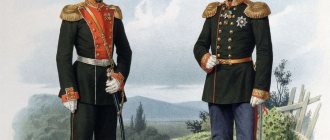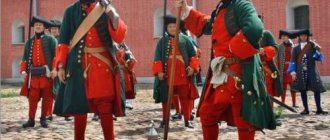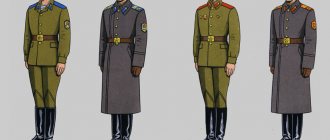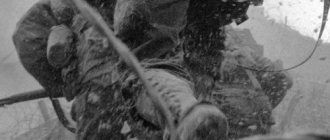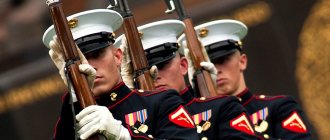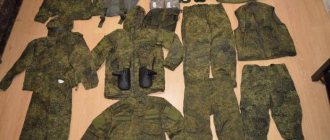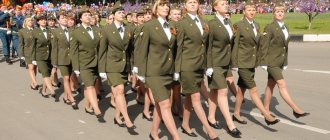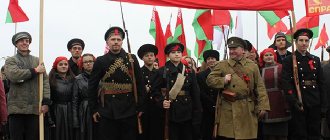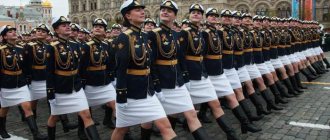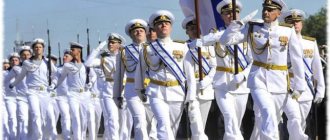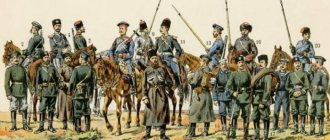Internal troops are a military formation within the structure of the Ministry of Internal Affairs of the Russian Federation; it existed from October 20, 1991 to April 5, 2016, that is, until it was transformed into the National Guard of the Russian Federation.
Unlike the Armed Forces of the Russian Federation, the Internal Troops are engaged in ensuring order within the state.
The Internal Troops of the Ministry of Internal Affairs of the Russian Federation were the direct successor of the Internal Troops of the Ministry of Internal Affairs of the USSR. Already in the early 90s, this military formation began its military path, as it participated in the first, and then in the second Chechen war.
Dress uniform of the Russian army: history
Wearing a military uniform, which includes historically established attributes and worn for special occasions, has developed in the army traditions of all states, including Russia.
At the same time, the modern Russian ceremonial military uniform of the Russian Army (RA) and Navy (Navy) combines the traditions of eras completely different in spirit and style: the Russian Empire, the Soviet Union and modern state and military paraphernalia. Since the formation of the Russian Empire, the special military uniform introduced by Peter the Great reflected his desire to reform the army along the lines of the advanced countries of that time. The elements and details of such ammunition (shoes, belts, cartridge bags, hats) were unified and were predominantly of a utilitarian nature, in demand in real use in campaigns and battles.
The cut of the officer's uniform was similar to that of the soldier's, but was trimmed with gold braid and gilded buttons. The main symbol of belonging to the officer corps was a special scarf, as well as a plume on a hat made of white and red feathers. One of the main attributes of the dress uniform of the Russian army was powdered wigs, which existed as a mandatory accessory until the reign of Alexander I.
The era of the Napoleonic wars and mass armies permanently changed the appearance of the military uniform of all armies towards simplification. This process fully affected the Russian army: during the 19th century, with the exception of certain “ceremonial” regiments, the dress uniform of officers and soldiers became more functional: “tailcoat” uniforms disappeared, and sewing was reduced. Under Alexander III, the military uniform was seriously unified, at the same time receiving a characteristic “national” look: wide trousers tucked into high boots; lamb ceremonial hats, etc. Long-range, rapid-fire weapons have forever done away with the multi-colored uniforms, bringing ceremonial versions of military uniforms closer to everyday ones.
After the revolution of 1917, all previous military ranks and titles in Soviet Russia were abolished, and in the soon created Workers' and Peasants' Red Army (RKKA), a special dress uniform was present mainly for the circle of senior command personnel. In addition, in the mid-1930s, in order to increase the prestige of service in aviation and tank forces, their personnel were approved for their own versions of dress and casual uniforms, differing from the general army in color and style.
The wearing of dress uniforms in the Red Army was not regulated until 1940, when the ranks of general and admiral were introduced, which finally completed the formation of a new system of military ranks, which has generally been preserved to the present day. In 1941-1942, it was planned to equip all Red Army personnel with ceremonial military uniforms, but with the beginning of the Great Patriotic War, these plans were curtailed.
The supply of clothing to all categories of military personnel in full dress uniform in the USSR was fully developed only in the post-war period. At the same time, two separate types of such uniforms were provided for the officers of the Soviet Army (as well as border and internal troops) - ceremonial and ceremonial-weekend, and each of them had winter and summer versions. The configuration of the Soviet ceremonial military uniform changed quite often; traditional stand-up collars and riding breeches gradually became a thing of the past.
The most characteristic appearance of the ceremonial military uniform is considered to be the one established in 1968. For privates and sergeants of the Soviet Army, the dress uniform was khaki and included:
- Open uniform;
- Long sleeve shirt and tie;
- Trousers;
- A cap with a colored band and a cockade;
- Leather belt with stamped buckle.
In winter, soldiers and sergeants wore a single-breasted overcoat and a hat with earflaps, which were included in both dress and everyday clothing. On the overcoat, as well as on the ceremonial jacket, shoulder straps with the letters “SA”, buttonholes and a sleeve chevron in colors established for specific types of the Armed Forces and branches of the military were sewn on.
The dress uniform of the Airborne Forces (Airborne Forces) required wearing a blue beret and a vest under the jacket. The basis of the officer's ceremonial uniform was the single-breasted jacket, and the rank of the senior command staff was emphasized by stripes on the trousers and gold embroidery on the uniforms and caps.
The dress uniform in the Armed Forces of the Russian Federation (RF Armed Forces) is worn strictly in accordance with the Rules for wearing military uniforms by military personnel, which are approved by order of the Russian Minister of Defense. At the same time, the continuity in the design of ceremonial uniforms with the Soviet military uniform in the first years of the existence of the RF Armed Forces was preserved almost completely, reflecting the changes that occurred with the collapse of the USSR only in the change of sleeve patches, as well as the replacement of the letters “SA” with “VS” on the shoulder straps of the ceremonial uniform of privates and junior command staff.
Headdresses in the Russian Army, on the contrary, have undergone significant changes since 1992. New cockades were introduced for all categories of military personnel (later changed more than once). In the winter version of the dress uniform of generals and colonels, hats were replaced with gray earflap hats. For the ceremonial uniform of conscripts, caps (as well as berets for female military personnel) were replaced by officer-style caps.
At the same time, the traditional division of the basic color of the officer’s uniform by branch of the Armed Forces was preserved: black and white for the Navy, blue for aviation, and sea green for the ceremonial uniform of the ground forces. However, in the period from 1994 to 2010 they tried to replace the last option (as well as the steel-gray general’s uniform) with a slightly modified olive shade of the same basic color, but in the end everything returned to the previous version. The ceremonial shoulder straps on the jackets of army conscripts and contract soldiers became a single protective color.
Subsequent changes occurred, as a rule, as the army's stocks of Soviet military uniforms, which had been accumulated in significant volumes, wore out. Instead of the ceremonial uniform and everyday jacket, a unified single-breasted French jacket without piping with patch pockets and buttons on the flaps, with sewn shoulder straps, was introduced for all military personnel.
The introduction of the new dress uniform of the Russian Army, in the development of which the famous fashion designer Valentin Yudashkin took part, after 2010 was supposed to be quite gradual and multi-year. The fundamental document regulating the procedure for wearing military uniforms by Russian military personnel was Order of the Minister of Defense of the Russian Federation dated June 22, 2015 No. 300 “On approval of the Rules for wearing military uniforms, insignia, departmental insignia and other heraldic signs in the Armed Forces of the Russian Federation and Order mixing items of existing and new military uniforms in the Armed Forces of the Russian Federation", with certain amendments, valid to this day.
The history of the emergence of the Russian Ministry of Internal Affairs from the 17th century to the beginning of the 1917 revolution
Unlike most European countries, in which, until the 18th and 19th centuries, the clothes of law enforcement officers were dark and nondescript, Russian law enforcement officers dressed brightly and flashily, since serving the Tsar was at all times considered a great privilege. In a country where the words “uniform honor” have never been an empty phrase, a beautiful police uniform could not help but appear.
In Russia, which was then called the Moscow State, the first police officers, called zemstvo yaryshki, appeared at the end of the 17th century. It was then that Tsar Alexei Mikhailovich, nicknamed “The Quietest,” transferred the functions of the Robbery Prikaz (which was engaged in the investigation and “knocking out” guilt and testimony) to the Zemsky Prikaz. It was in those days that people’s dislike for the police was rooted, and the Yaryshki received several offensive nicknames, derived from the letters “Z” and “I”, which were embroidered on their chests.
The first uniform of the then police were green Streltsy caftans with a red “Z” and “I” stripe.
In 1718, by decree of Peter I, a real police force was formed. Peter I, who was very responsible about every detail, himself established the uniform that police officers had to wear. According to the decree, the uniform of the first police consisted of the following elements:
- The caftan is bright blue (if you adhere to the exact text of the decree, then “cornflower blue”);
- The same color trousers and cap;
- The cuffs, cap lapels and uniform piping are red;
- Green camisole;
- Black tie.
The police uniform was either red or blue, different sources indicate this differently, perhaps there were two options at the same time.
Until the reign of Empress Catherine II, the uniform of the police, like the uniform of the Russian army, did not undergo any changes, both in Moscow and in provincial Russian cities. This state of affairs lasted until 1775.
In 1775, two acts of Catherine II appeared at once, which not only influenced the uniform of the Russian police, but also laid the foundation for the police hierarchy. The first act was “Institution for the management of the province”, and the second was “Charter of the deanery or police”. The police system that took shape in connection with these acts existed virtually unchanged until the second half of the 19th century.
In 1784, a decree was created according to which the police uniform was as follows:
- A caftan made of cloth with folded tails and a collar;
- Vest or camisole;
- Tricorne hat;
- Trousers;
- Stockings with boots, which were replaced in the equestrian ranks with special over-the-knee boots.
In addition, a sword was necessarily worn as a weapon. The color of the uniform depended on the province to which the policeman belonged:
- In St. Petersburg and the northern provinces the uniform was light blue;
- In Moscow and the surrounding provinces the color of the uniform was red;
- In Kyiv and other southern provinces, the color of the uniform was dark cherry.
Although the uniform was of the same type, the decoration of the uniform varied over a fairly wide range, which depended on the wealth of the owner of the uniform.
Under Paul I, the police were defined as a completely civilian service and independent from the army. In this regard, plaques were added to the police uniform, which depicted the royal double-headed eagle and indicated the position of the owner. The appearance of a junior police rank, a police officer, dates back to the same period, which later became the symbol of the Russian police until the 1917 revolution.
In 1808, the clothing of the Ministry of Internal Affairs of Tsarist Russia was updated. All officials of this ministry received the following form:
- Dress uniform;
- A service uniform of a similar cut.
The uniforms were dark green coats with a high collar and black velvet cuffs. The uniforms had coat of arms buttons made of yellow metal.
Under Emperor Nicholas I, who was a well-known expert on uniforms throughout Europe, a new police uniform appeared, which was introduced in 1834. This uniform was distinguished by a huge variety of different options, which were prescribed to be worn depending on the service functions performed. In any case, the main parts of the uniform were the following elements:
- Dress uniform;
- Vitsmundir;
- Uniform frock coat;
- Uniform tailcoat.
An official's overcoat made of cloth was developed especially for winter. 21 years later, in 1855, when the first police teams appeared, designed specifically to maintain and protect law and order in cities, a new reform of the police uniform took place.
Back in 1854, police officers received galloon shoulder straps, which they wore instead of epaulettes; longitudinal gaps and stars appeared on the shoulder straps, which showed the rank of the owner.
Lower police ranks (city officers) received the following uniform:
- Gray double-breasted semi-caftan;
- Gray trousers with red piping;
- A helmet with the coat of arms of the province to which the policeman belonged;
- A device made of yellow metal.
The weapon of lower police ranks was a massive cleaver, which was worn on a black leather belt.
The “Nikolaev” uniform underwent several changes and improvements, until in 1867 the police uniform underwent another reform. Under Emperor Alexander II, all police uniforms began to be made from dark green cloth. This is the color of all police uniforms.
Under Alexander III, who tried to awaken the “national spirit” in Russia, the uniform of the police (and the army too) began to closely resemble the Russian national folk costume in appearance and cut. Although the new style uniform was undoubtedly comfortable, most police officials considered it unworthy for a representative of the authorities to dress in a uniform of this style. The basis of the new model was a caftan, which did not even have buttons, but was fastened with special hooks. The caftan was dark green.
During the reign of the last Russian Emperor Nicholas I, the role of the police in Russia increased significantly. Due to the increased number of different revolutionaries, the role of the police in maintaining state law and order has increased significantly.
By 1904, the process of modernization of the Internal Troops of the Ministry of Internal Affairs was practically completed and the police suit acquired the form in which it existed until the 1917 revolution. The police uniform for junior ranks became double-breasted, and hooks were used as fasteners. Army-style trousers were used as trousers. The police uniform was worn with a belt that resembled a lancer's sash, or with a black patent leather belt.
The last years of the existence of the police in Tsarist Russia were marred by numerous murders of government officials. Moreover, they were killed both by revolutionaries, who were often criminal elements, and by ordinary crowds of people who staged pogroms.
What applies to clothing provision?
Once a serviceman enters service in the Russian army, he is paid by the state. Upon arrival at the military unit, they receive the necessary set of everyday uniforms. For viewings and festive events, dress uniforms are provided. You cannot do without bed linen and personal hygiene items during your service.
Military units require certain types of sports and mountaineering equipment to perform their duties. The list of clothing supplies is regulated by Government Decree No. 390 of June 22, 2006 and Federal Law No. 76 of 1998. All categories of military personnel receive uniforms, linen and hygiene items.
The government document sets out in detail the security standards:
- warrant officers and officers;
- soldiers, sergeants and foremen of conscript service and under contract;
- foremen and sailors;
- officers and midshipmen of the Navy;
- Coast Guard personnel;
- aviation flight and technical personnel;
- female military personnel;
- cadets of military secondary and higher vocational educational institutions.
The resolution is provided with tables indicating nomenclature units and the amount of property allocated to one serviceman. In addition, the service life of each item is specified there.
Often senior ranks teach recruits how to properly handle the clothes they receive.
What is regulated
Clause 20 of the Decree of the President of Russia on the creation of the FSVNG allowed the National Guard to wear the uniform of military personnel of the internal troops of the Ministry of Internal Affairs and the police until the government of the Russian Federation approves new models of uniforms and the procedure for providing appropriate uniforms. In this regard, the Decree of the Government of the Russian Federation of May 15, 2022 No. 580 “On uniforms, insignia and standards for the supply of clothing for persons serving in the troops of the National Guard of the Russian Federation and having special police ranks” appeared.
This document is currently the main legal act regulating the uniform of the Russian Guard military personnel, including in the following variants:
- By categories of military ranks;
- For men and women;
- For winter and summer periods;
- Depending on the climatic conditions of the regions of the Russian Federation.
As a feature of the uniform of FSVNG employees, it has been established that those performing service-combat (operational-service) tasks in mountainous and wooded areas, as well as in states of emergency, armed conflicts and counter-terrorism operations, are allowed to use items of special uniforms and items of special clothing camouflage colors.
Employees of the Special Purpose Center for Rapid Reaction Forces and Aviation of the FSVNG, as well as riot police and special forces, when performing their assigned tasks, are allowed to wear special uniforms of camouflage colors on a daily basis.
Global reform of the Russian army uniform
The modern history of Russia includes several unsuccessful attempts to change military uniforms. While our country was spending huge amounts of money on unsuccessful experiments, in the US Army, military clothing became more comfortable, its performance characteristics increased, and innovative materials were used in the production of clothing.
The modern military uniform began its journey in 2007, when the post of Minister of Defense was held by Anatoly Serdyukov. It was then that a large-scale sketch competition was organized, in which thousands of designers from all over the country took part. The Ministry of Defense awarded the victory to the famous designer Valentin Yudashkin.
For the next two years, specialists were developing the final versions of a new army uniform, intended for further equipment of the Russian Army. The result was a set of clothing that was in many ways similar to American uniforms. The developers did not agree with this opinion, although many factors spoke in favor of this comparison.
The winter military uniform caused particular dissatisfaction. It did not protect the soldiers from the cold. For this reason, the Ministry of Defense received many complaints every day about the poor quality of the winter kit. This led to an outbreak of colds among the military. There were also complaints about the appearance of the uniform: some stylistic solutions were copied from kits in other countries. The stumbling block was the quality of the fabric and thread: new military clothing quickly became unusable.
Negative reviews and dissatisfaction among soldiers and army specialists forced the Ministry of Defense to think about changing the equipment. The decision to take American clothing as a basis was a mistake; such costumes were not suitable for the conditions of our country. The new set of military uniforms, developed subsequently, consisted of 19 parts. The approximate cost of one set is 35 thousand rubles. The ceremonial version did not suffer any special changes, since the field uniform is of particular importance.
New field military uniform of the Russian Armed Forces
The first change that caught my eye was the change in the location of the shoulder straps on the uniform. In 2010, a “NATO” version was proposed, the shoulder straps in it were located on the “belly”. Many servicemen did not like this, since they were “used to seeing shoulder straps on their shoulders.” The chevrons on the uniform are located on both sleeves. An addition was the appearance of fitted overcoats, quickly secured clothing items with Velcro. For the first time in history, Russian officers received warm sweaters. It was not possible to completely replace foot wraps and boots.
Valentin Yudashkin was blamed for the failed project of a new military suit. In 2012, he spoke to reporters and stated that the clothes he used were very different from his version. In particular, to reduce costs, materials were replaced with lower quality ones. Journalists came to the conclusion that all that remained of the designer’s version was the appearance.
The new generation of military uniforms was developed based on feedback from thousands of soldiers from across the country. The shape of the aircraft has become multi-layered. This allows each soldier to independently choose the necessary items of clothing, guided by the goals and objectives assigned to him, as well as weather conditions.
The modified VKPO set includes a basic suit, several types of jackets, boots for different seasons and much more, including a balaclava, a synthetic belt and high-quality socks. Military uniforms are made from mixed fabric, which includes 65% cotton and 35% polymer materials.
Every soldier had new-style Russian military clothing at the end of 2022, as previously planned by the Ministry of Defense. The change of equipment took place in three stages. In 2013, 100 thousand new kits were issued, in 2014 - 400 thousand and in 2022 - 500 thousand. In 3 years, a million military personnel were provided.
The complete rejection of foot wraps deserves special attention. Modern images of military uniforms include 12 pairs of socks for one soldier, which he uses throughout the year. It is planned to soon increase the number of pairs per military man to 24.
VKPO kits for wearing at different atmospheric temperatures
The new model military uniform is presented in two sets:
- Basic uniform for wearing at temperatures above +15 degrees Celsius;
- Multi-layer system for wearing in temperatures from +15 to -40 degrees Celsius.
In winter, soldiers wear lightweight or fleece underwear sets. They are selected depending on the air temperature. In particularly cold areas, both sets of underwear can be worn one on top of the other.
For equipment in the summer, trousers, a jacket, a beret and boots are used. The surface of the clothing is carefully treated with an innovative solution that repels moisture. It allows clothes to remain dry in the rain for up to two hours. To protect against mechanical influences, military clothing is equipped with reinforcing elements. Such kits are used in parts with a high degree of load.
The rules for wearing military uniforms allow you to use a fleece jacket in the autumn season: excellent thermal insulation is provided by the pile with which it is covered on both sides. A windbreaker jacket, worn with fifth-layer trousers, protects from strong winds.
A demi-season military suit is intended for the autumn period. The material from which it is made provides reliable protection from the wind, a good degree of vapor permeability and dries quickly after getting wet. During heavy rainfalls, it is permissible to use a wind and water protection kit. The membrane and reliable sizing of the layers provide reliable protection from moisture.
History of the Russian Guard and internal troops
Military service by conscription is considered an honorable duty for a man, and the branch of the military in which he will serve often matters only for the soldier’s personal pride. The state is equally important to the “elite” units - the Aerospace Forces, Airborne Forces, Navy, Marine Corps, and troops called upon to protect strategically important facilities within the state. Therefore, each branch of the military has a special purpose, which was developed based on the experience of previous generations and military science. This experience was paid for with considerable blood.
Russia is a very socially contradictory state, the history of which is replete with riots, uprisings, and separatist manifestations aimed at splitting internal unity. This trend can be traced throughout the history of the state.
For the first time, the prototype of the internal troops was created under Tsar Ivan IV the Terrible. He specially gathered for three months personally devoted young nobles who served to protect Moscow from mob riots. Subsequently, these functions were transferred to the guardsmen for a short period.
Peter I also left a mark on the history of the internal troops. It was under him that armed detachments of disabled people and recruits unsuitable for combat service began to be formed to maintain order in cities and fight rioters. But Alexander I can be considered the father and founder of the internal troops.
It was by the Highest Decree of Alexander I on March 27, 1811 that disparate military teams of disabled people, subordinate to the provincial authorities, were resubordinated to a single high command and acquired the status of military formations with absolutely specific goals - protecting the interests of the state from internal enemies.
Modern ceremonial military uniform of the Russian Armed Forces
The basic design of the dress uniform has not changed for many years, as it continues to meet modern requirements while paying tribute to history. Only a few elements have been replaced in recent years due to their obsolescence. The dress uniform is worn at parades, holidays, when receiving military awards, etc.
In the Russian army there are three approaches to the formation of such a set of uniforms:
- Traditional. Clothing sets include elements created back in the 19th century. A good example is the ceremonial outfit of the Presidential Regiment of the Russian Federation - their costumes are identical to the uniform of the Imperial Guard, adopted in 1907;
- Modern. The cut of the dress uniform corresponds to the daily set; the same colors can be used. For example, in the Armed Forces of the Russian Federation, the color of the ceremonial jacket coincides with the everyday one. Casual elements are complemented by ceremonial elements;
- Universal. The color of a ceremonial suit can be the same as the everyday one, but the colors of the ceremonial elements must be different.
The dress uniform must strictly meet the following standards:
- The style of the military uniform of military personnel of the Russian Army must be observed;
- A military suit for ceremonial purposes should be strict and elegant;
- Only high-quality materials should be used in production.
Changes to the design of the dress uniform are rarely made; its main style is determined by history. Various additional elements may change each year. Changing the materials used in production is permissible only if it improves the quality and performance characteristics of the suit.
The general's ceremonial outfit deserves attention. It is also similar to a casual suit, but has a difference in color. The color of the dress uniform is gray, worn with bluish trousers and black boots. There are stripes on the collar and cuffs.
History of the T-70
The first samples of the T 70 tracked tractor left the assembly line in 1974; production was discontinued in 2008 due to obsolescence. The MTZ-80 tractor was used as a prototype, converted to caterpillar tracks. Some technical solutions and units are entirely borrowed from the T-50 and T-54 tracked models previously produced by the plant. The development of the tractor was carried out with the technical assistance of specialists from Kharkov, Minsk and Altai.
Interesting! The T70 tractor is distinguished by a technically well-developed and simple design, safety margins, good build quality, availability of spare parts, their unification with other models, technical ease of repair without contacting specialized workshops. This has led to the fact that the tractor continues to be widely used on farms ten years after the end of serial production.
Headquarters uniform
Office clothing for those who work in ministerial offices of the Armed Forces consists of:
- soft green cap or beret;
- shirts without a tie with Velcro shoulder straps;
- white T-shirt under the shirt;
- trousers
In cold weather, it is recommended to wear a warm jacket with a hood and a hat with earflaps. Shoulder straps are attached to the shoulders of the suit. Although the office uniform is an everyday uniform, it is not allowed to be used in the field.
Are there secret formations in these units?
A simplified name for special units (including secret ones), whose tasks include performing special tasks - special forces. The number of this unit fluctuates around 18 thousand personnel. Soldiers from special forces can belong to various departments; they are united by the tasks and goals that are assigned to them. This list includes:
- Counterintelligence and anti-sabotage activities. In the event of hostilities, explosives can also engage in sabotage against the enemy. Suppressing the activities of foreign spies and preventing sabotage are the basic principles in protecting the integrity of the state.
- The fight against terrorism and participation in counter-terrorism activities. The tasks of the special forces also include the release of civilians held hostage by criminals. VV special forces participate in the capture and destruction of organized gangs.
- In exceptional cases, special forces may be involved in ensuring internal security and maintaining public order. Despite the fact that these tasks are part of the specific activities of the Internal Troops of the Ministry of Internal Affairs, special forces are involved only in cases threatening emergencies or mass civil unrest. Another common reason for contacting is a difficult situation in crime-prone areas or the liquidation of organized criminal groups.
- Other complex tasks that are beyond the capabilities of other units of the internal troops. This includes: storming buildings and objects, clearing areas of criminal elements, conducting military operations within the boundaries of a populated area.
The Internal Troops of the Russian Ministry of Internal Affairs is one of the most numerous and sought-after military structures in the country. Its tasks include both the daily provision of order and peace of citizens, and the implementation of special tasks related to the preservation of state security and integrity.
| Did not find an answer to your question? Call a lawyer! Moscow: +7 (499) 110-89-42 St. Petersburg Russia: +7 (499) 755-96-84 |
Color Differences
The color design of the military uniform depends on the branch of the army:
- Navy recruits wear dark blue uniforms. The color white is present in clothing, especially for summer clothing. This is due to hot weather, because white color better reflects ultraviolet rays.
- Ground forces wear green uniforms. The shade of the material on formal clothing changes. It is closer to the color of sea green.
- The blue shade of clothing is typical for flight personnel serving the Military Space Forces.
The cap badges also differ in color. The infantrymen have a golden cockade with a red band. In the space forces - blue, in the artillery, rocket and tank crews - black. The emblem of the military branch is placed on the crown of the caps. It is made of metal with gold plating. Ceremonial hats and everyday caps are made of blue material for military personnel of the Aerospace Forces, and black for the Navy.
Shoulder straps and insignia on clothing
For officers, both senior and lower ranks, it is mandatory to attach removable shoulder straps to the shoulders. They are attached to summer and winter clothes. Wearing shoulder straps is mandatory for cadets of military schools.
The shoulder straps must have rank insignia. For senior officers - stars, petty officers, sergeants, corporals - stripes. They are located longitudinally along the entire length of the shoulder straps and transversely. There are lapel and sleeve insignia of belonging to the military branches on the clothes.
The field uniform is decorated with stripes on the chest on the right - Russian Armed Forces, on the left - the surname and initials of the serviceman. The color of the edging of the patches depends on the type of troops. So, for VKS it is blue. The procedure for wearing honorary badges and medals on clothing is determined by order of the Ministry of Defense of the Russian Federation.
New dress uniform for military personnel
Military personnel of the Russian Armed Forces wear full dress uniform:
- When participating in parades and official events with the participation of troops (forces);
- On holidays of the military unit;
- Upon receipt of state awards;
- When presenting a military unit with the Battle Banner;
- When launching a ship entering service, when raising the Naval flag on the ship;
- When appointed to the honor guard;
- When serving as sentries to protect the Battle Banner of a military unit.
In addition, military personnel are allowed to wear full military uniform on weekends, during off-duty periods.
From the officers
The new dress uniform for officers of the Russian Army was first presented on May 9, 2022 during the parade on Red Square in Moscow. Its main feature is a closed, single-breasted, sea-green colored uniform (for officials of the Ministry of Defense with the highest class ranks - gray (with a silver device); for the dress uniform of generals and officers of the Aerospace Forces - blue), on six gilded coat of arms buttons, with piping board, collar and cuffs.
Selection for service in the Russian Guard
The practice of selection into the internal troops (VOKHR-VNUS-VChK-OGPU-NKVD-VV) has developed a strict rule: in no case are they conscripted for persons with a criminal record
It doesn’t matter whether it’s withdrawn or cancelled. In the same way, candidates are not considered for persons against whom criminal cases were initiated, but were terminated due to exonerating (due to the lack of corpus delicti) or non-exonerating (due to lack of evidence or expiration of the statute of limitations) circumstances.
Considering the small need of the Russian Guard for conscripts, the conscription service in the Russian Guard places increased demands on the criteria of psychological stability, an impeccable pre-army biography and physical training. Young men who were brought up in single-parent (foster) families and who were registered with drug treatment or psychoneurological dispensaries are not usually considered as candidates.
Equipment and appearance of office uniforms for military personnel of the Russian Armed Forces
The office set includes a shirt, jacket, and trousers of a classic cut. The difference in costumes by gender lies in the addition of a straight-cut skirt for female military personnel.
Uniform of military personnel of the Russian Armed Forces for wearing in the office (men's and women's suits)
The set of summer uniforms for women with a military rank includes:
- khaki cap (for Army servicemen) made of woolen fabric;
- a casual hat, in color corresponding to the uniform;
- blouse and shirt with short sleeves;
- blouse and long sleeve shirt;
- a strict skirt made of plain-dyed cotton-polyester fabric;
- wool trousers;
- suit jacket with short sleeves;
- suit jacket with long sleeves;
- tie;
- black shoes made of genuine leather with stable heels (333 Type B);
- flesh-colored tights.
New uniforms for various services of the Ministry of Internal Affairs
The new form for traffic police officers consists of the following elements:
- Demi-season jacket with hood;
- Winter jacket with a fur collar, which is removable. There are emblems on the collar, and the jacket itself has a hood that can be removed;
- Demi-season trousers;
- Insulated winter overalls. There are reflective stripes on the sides of the trousers;
- Summer jacket and trousers with a straight silhouette;
- Wool-blend sweater;
- Shirts with long and short sleeves.
For special purpose police units, uniforms were developed taking into account all the tasks that may arise during their difficult work. An interesting solution, for example, is the presence of special ear holes, which are found in the hoods of new riot police jackets. This allows you to use headphones without removing the hood and provides the audibility that is essential during operational tasks. This feature of the jacket was developed precisely at the request of special forces, who successfully tested it when working with radio headsets.
To ensure that various weather conditions do not interfere with the performance of duty, winter trousers and jackets of riot police are equipped with special bags that are stored in pockets. If necessary, you can quickly put winter clothes in these bags to change clothes in accordance with new weather conditions.
In the new police uniform, the functions of fasteners are performed not only by zippers, but also by Velcro. Although they are designed to make life easier for employees of the Ministry of Internal Affairs, they actually represent a constant headache, since they often lose their properties during operation.
The summer riot police uniform has ventilation valves in the armpit area. In addition, the equipment set includes tactical gloves made of leather and textile. Boots for riot police officers (high boots) are made of thick leather, which is coated with a water-repellent composition.
Additional information about the new office uniform in the army
According to the Order of the Ministry of Defense, wearing uniforms, departmental and heraldic insignia is an obligation not only for military personnel, but also for federal government civilians working in military departments and departments, the General Staff, and the Ministry.
The new uniform is identical for military personnel and civilian personnel of the Russian Armed Forces in terms of cut and quality of fabric used. Distinctive features are insignia: army shoulder straps, buttonholes and other chevrons, heraldic insignia for federal government civil servants.
Sleeve insignia for civil servants correspond to a specific department (department), and are placed on the right sleeve of a jacket or shirt. Breast badges for civil servants reflect: the right-sided ones - belonging to the Armed Forces, have the inscription “Ministry of Defense of Russia”, the left-sided ones - the surname and initials.
For civilian personnel with a class rank, the uniform is distinguished by the silver (gray-white) color of the device, for military personnel - the gold (yellow) color of the device. Civil servants of the RF Armed Forces with the rank of State Counselor are required to wear shoulder straps on their jackets, winter uniforms and shirts.
The location and appearance of buttonholes on the office uniform of ground forces officers
Location of police chevrons
Russian Air Force uniform: everyday and dress, what changed after Shoigu’s reform
Police sleeve insignia are sewn at a distance of 80 mm from the shoulder seam or fold. If there is a pocket on the sleeve, then the patch is sewn in the center of the pocket.
- On the left sleeve there is a common sleeve chevron of the Ministry of Internal Affairs of Russia
- On the right sleeve there are chevrons of the Ministry of Internal Affairs indicating that the employee belongs to a specific unit.
- The “Police” patch on the back is 1 cm below the red stripe.
- The “Police” patch on the chest is 1 cm above the left pocket.
Cadets wear rectangular “course” stripes, in the number corresponding to the course of study (one in the first year, two in the second year, etc.) They are located on the left sleeve, at a distance of 20 cm from the top of the sleeve, to the top point of the stripe.
| Location of Ministry of Internal Affairs stripes: diagram | Location of police chevrons on a shirt: diagram |
Special cases of location of police badges
For outdoor service.
Sheepskin coat or jacket
— badge, left side of the chest, 4 cm below the “Police” badge, secured with a pin.
Summer, demi-season, winter, wind- and moisture-proof jackets, windproof raincoat
- Pocket patch, breast badge, left breast pocket, secured with a pin. + for shirts, blouses, jumpers and sweaters - a badge, a flap of the left breast pocket, using a button or pin fastening.
Summer, demi-season, winter, wind and waterproof jackets, coats and jackets made of winter sheepskin
— “Police” patch on the back and left shelf — for all except combat traffic police units.
For cavalry units.
Summer, demi-season, winter, wind- and moisture-proof jackets, windproof raincoat
— breast badge, left breast pocket, secured with a pin. + for shirts, blouses, jumpers and sweaters - a badge, a flap of the left breast pocket, using a button or pin fastening.
Summer, demi-season, winter, wind and waterproof jackets
— “Police” patch on the back and left shelf.
For combat units of the traffic police.
Summer, demi-season, winter jackets
— “DPS traffic police” badge on the left shelf.
Summer, demi-season, winter jackets, waterproof raincoat, signal jacket
— “Police” patch and the letters “DPS” on the back, made of reflective materials.
Signal vest
— the letters “DPS” on the back, made of reflective materials.
| Location of traffic police stripes: diagram and photo. Order | Location of traffic police stripes: diagram and photo. Order |
For the Special Forces Center for Rapid Reaction Forces, Riot Police, SOBR
Camouflage green clothing
- the sleeve insignia is not worn.
The OMON and SOBR chevrons are made in one color so as not to attract attention. Depending on the color of the uniform, these are threads of protective or bluish-gray shades
| Location of patches on the camouflage blue uniform of the riot police | Location of patches on the SOBR special forces field uniform |
Still have questions about the placement of the Ministry of Internal Affairs chevrons? See the article How to sew a chevron?
Winter and summer dress uniform
The global reform did not affect the main concept of uniforms for special occasions. The changes affected obsolete elements.
Ceremonial uniforms are intended for celebrations. In Russia, she uses three types of military clothing for special occasions:
- Traditional, created in the last century. For example, the Presidential Regiment of the Russian Federation wears the uniform adopted at the beginning of the 20th century.
- Modern, suitable for everyday wear, complemented by festive elements.
- Universal. In such equipment, the colors of the ceremonial elements differ from the colors of everyday uniforms.
There are also differences between the uniform of the honor guard and all other military formations.
What elements does summer clothing for special occasions consist of:
- Cap made of natural wool with a band. For higher ranks, sewing should be used.
- Ceremonial uniform with shoulder straps and buttonholes. For senior officers, sewing is used.
- Trousers made of natural wool fabric. The senior staff wears stripes.
- Dress uniform for military officials, or uniform.
- Snow white shirt.
- Ceremonial exit belt.
- Black tie and brass bartack.
- Low shoes/chrome boots.
- White kid gloves.
Winter ceremonial costume includes:
- Fur gray earflaps. For senior staff - from astrakhan.
- Dress-up coat.
- Demi-season or winter boots/low shoes.
- All items of clothing are flight version, except for the cap.
Basic requirements for a formal uniform: compliance with historical style, rigor, elegance, high-quality materials.
The general's uniform has a special color scheme. The exit uniform should be gray, trousers - blue, shoes - black. The stripes are located on the collar and cuffs.
Uniform of the Internal Troops of the Ministry of Internal Affairs of the Soviet era
In February 1917, a revolution occurred in Russia, which put an end to the history of the Russian police, which by that time was more than 200 years old. Since the main role of the Russian police was to maintain law and order, a wave of murders of police officers, who were recognized precisely by their uniform, swept across the country in unrest. First of all, those police representatives died for whom the words “uniform honor” were not just a phrase. The common people, who suddenly gained power into their own hands, hastened to deal with representatives of the authorities who had been inaccessible to them for two centuries.
On March 10, 1917, the Police Department officially ceased to exist, although by that time it was no longer relevant, since the police at that time no longer existed in Russia. Nevertheless, revolutionaries, concerned about the crime situation on the streets of big cities, began to create voluntary detachments that patrolled the streets. Each such detachment was assigned a commander who knew the area very well.
On March 4, 1917, the first detachments of the Petrograd People's Militia were created. As a uniform, these units used white armbands, on which were written the red letters “G.M,” which meant “city police.” Already in the summer of 1917, an attempt was made to create a unified uniform for the police, but since there were enough other concerns at that time, this project remained at the development stage.
In August 1918, army uniforms were introduced for all branches, one of the original items of which was a canvas raincoat, which was used in the automobile army units of the tsarist army.
The Workers' and Peasants' Militia, which was formed back in 1917, received special care from the Soviet government. This body was supposed to become not only a replacement for the tsarist police, but also a symbol of Soviet power in the eyes of the Russian population. In 1918, at a meeting of the NKVD board, which took place in the fall, a uniform for police officers was approved. It was summer and winter and consisted of the following elements:
- The summer uniform consisted of a jacket with pockets, jodhpurs, a cap and boots complete with windings. Already at that time, the uniform was dark blue, which subsequently accompanied the uniform of the Soviet police for several decades. The jacket was fastened with 5 large uniform buttons. Small buttons were sewn on the collar, pocket flaps, cuffs and collar;
- The winter uniform had a rather unusual color “marengo” (dark gray, with a bluish tint). It was complemented by a Finnish-type winter hat, which had a leather visor and a trim resembling lamb's wool (faux fur). In addition, the winter uniform was complemented by a double-breasted coat with a fur collar, and for guard duty, police officers were required to be issued sheepskin coats.
In the summer, police officers were required to wear brown thread gloves, and in the winter, black leather gloves with lining.
Judging by the information available in the archives of the Ministry of Internal Affairs, in those years there was also a women's uniform, which consisted of the following items:
- Single-breasted black coat;
- French;
- Tunic;
- Skirt and beret.
This uniform was made in a blue color scheme, and women began to be accepted into service in the Soviet police in 1919.
Although the Soviet government took a very responsible approach to the creation of uniforms for the police, until 1923 the main uniform for police officers was a standard military uniform, and women’s options, if they existed, were in single copies.
In 1924, when the situation in the young Soviet country had somewhat stabilized, the police uniform underwent modernization, the main goal of which was to simplify production technology. The main differences of the modernized police uniform were as follows:
- Maroon collars became the same color as bekeshes and French collars;
- The administrative staff now have black buttonholes with white edging;
- The departmental police received turquoise buttonholes with black edging. The uniform received a turquoise edging.
In 1926-27, when the NEP in the RSFSR began to be phased out (it was officially closed in 1931, although it was actually phased out in 1928), the colorful uniform of the Soviet police began to become a thing of the past. Stalin's new totalitarian regime demanded a completely different image of the police, strict and stern, which would instill fear in the Soviet population by its very appearance. Beautiful and elegant overcoats are a thing of the past; in their place came strict single-breasted military overcoats, black, which were fastened with hooks. Winter hats for some time remained the same cut, although they began to be made from black cloth and the same color faux fur. The mounted police, who sported blue uniforms, now dressed all in black, like the rest of the RCM services.
In 1938, the time came for another reform in the field of police uniforms. The entire RKM team received khaki overcoats. The most significant changes appeared in the uniform of the commanding personnel:
- New winter fur hats, which were made of brown fur with a characteristic “cap” of gray-green wool fabric;
- A jacket for everyday wear in steel color;
- White lungs of the jacket;
- Pants for summer are white;
- Winter blue trousers.
The beautiful uniform of the Soviet police, which stood out favorably among the monotonous clothing of the civilian population of the USSR, lasted until 1958. This year, when the country was swept by a wave of democratization, the image of the policeman underwent significant changes:
- The beautiful double-breasted uniform was replaced by a simple blue jacket, which had welt pockets and was cut like a military uniform;
- The only insignia on the new jacket are the shoulder straps and red piping. As for the shoulder straps themselves, sewn-on shoulder straps began to become increasingly popular;
- The casual shirt was blue, and the dress shirt was white. All shirts were worn with the same type of tie with an elastic band;
- Trousers could now be worn untucked by all police personnel, even privates.
After this reform, the colorful image of the Soviet policeman remained a thing of the past forever.
In 1969, a uniform reform took place in the USSR army. In this regard, an order of the Ministry of Internal Affairs was published, which provided for updating the police uniform. The main point of this order was the replacement of the blue color of the police uniform with gray, which remained the dominant color of Russian law enforcement officers until recently. The Ministry of Internal Affairs also ordered that the cut of the police uniform be brought into line with the basic cut of the army uniform. This innovation made it possible to significantly reduce the cost of uniforms for law enforcement agencies.
After this reform, the clothes of the Soviet police began to look like this:
- Jackets, both winter and summer versions, began to be made with turn-down collars and single-breasted. They were fastened with 4 brass buttons. The summer jacket was made from half-wool, and the winter jacket from wool;
- Two raincoats of the same type, one nylon and the other rubberized. All cloaks had a secret clasp, a fastened hood and a belt;
- A coat made of woolen fabric with a turn-down collar, which was fastened with 3 buttons. An army overcoat was left for the mounted police;
- In winter, the uniform was issued with a gray muffler and gloves.
In 1984, a blue-gray summer shirt with short sleeves appeared in the uniform of the Soviet police, which was used for all climatic regions of the USSR.
The uniform of the Ministry of Internal Affairs of the Russian Federation in the 1990s was not much different from the Soviet one. The only example of modernization is camouflage of various colors, which was issued mainly to special forces, riot police, and so on. Many private companies appeared that began to sew some types of uniforms and shoes. The production of field models of uniforms has become especially popular. As an example, we can name, which is one of the most famous Russian companies for the production of uniforms and shoes.
